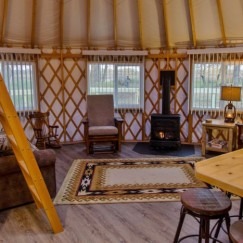Electricity and Plumbing in Your Yurt – What You Need to Know
Yurt living has come a long way since 400 CE. That’s approximately when peoples of the central Asian Steppe began using circular, portable housing now commonly known as yurts. Today, every modern convenience can be built into a yurt, given careful planning. Modern yurts may feature appliances, lighting, heating, plumbing, and even lofts. Through our Yurt Builder 3D, you can envision yurt personalization options, including window placement, construction materials, central dome options, and more.
As the makers of the original modern yurt, Pacific Yurts delivers the wood frame, lattice wall, rafters, center ring, dome, and all other yurt components. After assembling your yurt onto a site-built platform, you can employ a contractor to add plumbing and electricity, including interior lighting fixtures.
The first step is to assess the facilities on site. The ability to add electrical and plumbing systems depends on the location. If your land already has an electrical utility hookup, it will be far easier to add electricity in your yurt. The same is true for plumbing and septic hookups. If you don’t have a septic tank or municipal sewage hookup, you’ll need to arrange septic storage on site. Another alternative is to design an off-the-grid approach to managing your own waste (such as through composting toilets and grey water reuse. Custom yurts with electricity and plumbing require expertise from local licensed professionals. Be sure to contact one before you decide to customize your yurt.
Read on to learn the basics of adding electricity and plumbing to yurts and download our checklist below.
Electricity Options for Yurts
Electricity may be wired underneath the yurt platform. Outlets may be installed onto posts at the perimeter of the yurt or into the floor. If interior partition walls are constructed, wiring and outlets could be added into them as well.
Lighting Options for Yurts
Assuming you have procured some energy source (solar, utility hookup, wind, etc.) any form of lighting is available to you. Yurt owners generally keep some emergency options on hand, such as oil lamps and candles as well. Low-voltage lighting is popular among yurt owners, as it doesn’t require much power. LED lights are also a great lighting choice because they draw only a sliver of the energy needed to power incandescent and other forms of light. Track lighting can be either mounted along a single rafter or across multiple rafters, while other overhead light fixtures could be mounted between rafters. Let your imagination go wild!
Plumbing Options for Yurts
Pipes may be installed underneath the yurt platform and brought up through the floor. If your site provides for access to a sewer or septic system the yurt’s piping could be connected to the system. Interior partition walls also allow for piping to be concealed within them.
Alternative Energy Options for Yurts
All of the above assumes that your yurt is in a fairly urban locale, where electrical and sewer hookups are available. For those who want to be truly independent, there are eco-friendly options that can be established nearly anywhere. Eco-conscious yurt owners are increasingly choosing to go “off the grid” with alternative energy options such as:
- Composting Toilets
Why worry about sewage when you can process your own waste into fertilizer? Composting toilets are available commercially, or you can build your own. Just ensure that you’re following local and state codes on toilets. Many composting toilets feature a separate holding/processing tank, often located in a basement or outdoors. With the right design, your composting toilet tank could be located beneath the yurt’s platform. - Solar Power
A solar panel array outside your yurt can accommodate your family’s needs. Solar panels are best situated in full sun, facing south. Using a rustic setup, you could gather 90 watts of energy from a couple of solar panels charging two deep cycle marine batteries. For full electrical power, a larger, more sophisticated solar system would be required. - Wind & Water Power
If your yurt is located in a breezy area, wind power may be a viable electricity source. Of course, if the wind isn’t blowing, the turbine isn’t turning and no electricity is being created, meaning that the system’s batteries must be capacious enough to store energy. A 24/7/365 option would be a micro hydro system, situated along a stream. In a micro hydro system, falling water turns a turbine, producing energy. Assuming your stream runs all year long, you could harvest energy continually.
Browse our yurt photo gallery for more ideas on lighting, plumbing, and furnishing your yurt. As you work to bring your yurt dreams to fruition, it’s important to remember to partner with a local construction expert.


